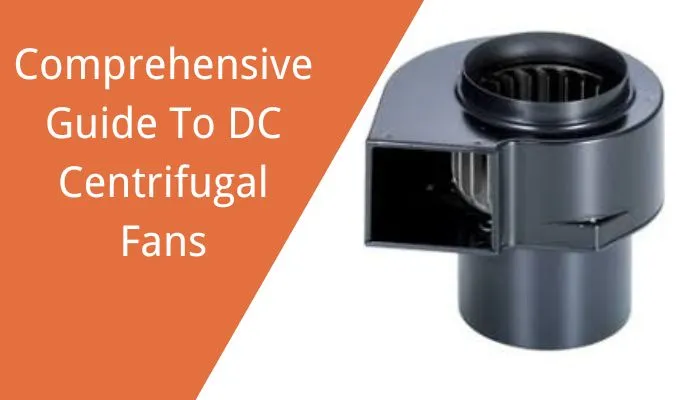DC centrifugal fans dominate the ventilation and movement of air. Frequently eclipsed by their AC partners, DC centrifugal fans offer an interesting mix of effectiveness and precise control. And the flexibility that moves them to the front of different applications. So, this complete guide digs into the universe of DC centrifugal fans and explores their inward activities, different sorts, and the many benefits they have. We’ll disclose the mechanics behind their activity and shed light on the different accessible, cutting-edge setups. Plus, it exhibits the advantages that make them a convincing decision for many enterprises and settings. Toward the end of this investigation, you’ll understand how DC outward fans can raise your air and take care of requirements.

Table of Contents
ToggleDefinition and Working Principle of DC Centrifugal Fans
At the core of a DC radial fan lies a DC engine. At the point when power is applied, the engine’s inward parts create a rotating attractive field. So, this attractive field connects with long-lasting magnets mounted on the impeller (fan cutting-edge gathering), making it turn. And the rotating impeller bestows energy to the air, speeding it up outwards and making airflow.
The impeller in a radiating fan is commonly planned with curved sharp edges. As air enters the fan lodging, the impeller edges speed up radially outwards. Because of radiating power (the outward power experienced by a turning object). And this makes a compressed air stream that leaves the fan through a particular outlet. Thus, the edge configuration (forward-bended, reverse-bended, or airfoil) impacts the fan’s wind current qualities (strain and volume).
Components of a DC Centrifugal Fan
- Impeller
The impeller is the core of the fan, behaving like a rotating pump for air. And it comprises a focal center, ordinarily associated with the engine shaft. Plus, various sharp edges expanding outwards. As the engine turns the shaft, the impeller blades pivot quickly.
- Housing
The housing encases the fan’s sharp edges and engine. Which giving a smoothed-out construction to productive wind stream. And shielding the pivoting parts from flotsam and jetsam. Sheet metal is the most common material for housings. And it can be designed with forward, backwards, or airfoil blade configurations.
- Motor
The engine’s motor gives the ability to pivot the fan edges. Engines in central air frameworks can be PSC (Permanent Split Capacitor), ECM (Electronically Commutated Engine), or brushless DC engines. Therefore, the sort of engine picked relies upon the particular necessities of the framework. Like proficiency, wind stream prerequisites, and noise levels.
- Bearings
The heading supports the alternating shaft of the engine and fan edge get together. Which considers smooth rotation with low friction. Metal balls are typical in air conditioning fans. As they offer a decent equilibrium of execution, toughness, and cost.
Types of DC Centrifugal Fans
- Backwards Curved DC Centrifugal Fans
- Forward Curved DC Centrifugal Fans
- Radial DC Centrifugal Fans
Key Features and Benefits of DC Centrifugal Fan
High Tension:
So, they are equipped to produce huge static strain. Which making them appropriate for applications requiring airflow over significant distances or through complex ventilation work.
Productivity:
For the most part, it is effective in changing input energy into wind stream. Particularly when furnished with reverse bended edges.
Adaptability:
Accessible in different designs (forward-bended, reverse-bended, spiral) to suit different execution prerequisites.
Robustness:
Further, they are solid and ready to deal with cruel working circumstances. Including high temperatures and destructive conditions.
Low Noise Levels:
Depending on the design and operating speed, they can produce moderate to high noise levels.
Applications of DC Centrifugal Fans
1. HVAC systems
Moreover, centrifugal fans are fundamental to heating, ventilation, and cooling (central air) frameworks. And they work with air dispersion by moving molded air through ventilation work to different pieces of structures. Which guaranteeing uniform temperature and air quality.
In air handling units (AHUs), these fans give ventilation and temperature control in enormous business and modern structures. Also, these fans are significant in exhaust frameworks. Because they eliminate lifeless or defiled air, keeping up with legitimate indoor air quality.
2. Industrial Processes
Plus, pneumatic conveying systems are used to transport dust, sawdust, and other particles in material handling systems. So, these fans likewise assume a crucial part in drying and cooling processes. Which giving vital airflow in modern dryers and cooling frameworks fundamental for tasks. For example, food handling and compound creation.
In addition, industries like metalworking and power generation use centrifugal fans to supply combustion air to furnaces and burners. Which ensures efficient combustion.
3. Automotive Industry
Also, the automotive industry makes significant use of centrifugal fans. As they are utilized in engine cooling systems to help maintain optimal engine temperatures. By providing airflow to intercoolers and radiators. In vehicle cooling frameworks, these fans improve execution by moving air through evaporators and condensers, guaranteeing effective cooling.
In mining and burrowing tasks, centrifugal fans are pivotal for ventilation. Because they provide underground workers with clean air. which makes sure they can breathe. Also, these fans eliminate unsafe gases and residue from mining burrows, forestalling perilous form ups and guaranteeing specialist wellbeing.
How to Selecting the Right DC Centrifugal Fan
- Determining Application Requirements
Recognize the primary function of the fan in your system—such as dust collection and ventilation. Distinguish a particular necessities or limits. For example, temperature control or impurity taking care of.
- Calculating Airflow and Pressure Needs
Decide the necessary volume of air the fan needs to move each moment. Compute the strain expected to conquer opposition in the ventilation work (if pertinent).
- Assessing Energy Efficiency
Plus, search for fans with high CFM per watt appraisals. Which showing effective air development with lower energy utilization. Consider highlights like variable speed control for additional improvement.
- Noise Considerations
Assess noise and commotion level details (sone rating) in view of your application’s clamor senstvity. Forward-bended cutting edges will quite often be noisier than in reverse bended or airfoil designs.
- Size and Space Constraints
Measure the accessible space for the fan and guarantee the picked model fits easily. Think about the heaviness of the fan, particularly for housetop or suspended applications.
Conclusion
With their remarkable capacities and versatility, DC centrifugal fans have a speciality in various applications. From the calm hum of PC cooling frameworks to the vigorous presentation in modern cycles, these fans offer a convincing answer for different necessities. And their productivity, exact controllability, and extensive variety of designs make them an important resource for any industry looking to streamline air development. In this way, next time you experience a strong wind stream or a murmur calm cooling framework, think about the concealed legend behind it – the DC outward fan, a demonstration of development in air dealing with innovation.
FAQs
What is the difference between AC centrifugal fans and DC centrifugal fans?
AC and DC centrifugal fans vary in their center: the engine. AC fans utilize fixed-speed AC motors, while DC fans have variable-speed DC engines. This means calmer activity, more prominent proficiency (particularly at lower speeds), and exact wind stream control for DC fans – pursuing them a prevalent decision when these elements are essential.
What is a DC centrifugal fan?
A DC centrifugal fan is a kind of fan that uses a DC engine to produce wind current. It includes an encased housing with an impeller (a turning blade assembly) at its center. As the DC engine turns the impeller, the cutting edges speed up air outwards because of divergent power, making a coordinated and compressed air stream.
How does a DC centrifugal fan differ from an AC centrifugal fan?
There are a few benefits to utilizing DC radial. They are more energy efficient because they can precisely control the fan speed and use less. This precise control can adjust the airflow adjusted to meet specific requirements. Also, DC engines will quite often produce less electrical commotion, bringing about calmer activity contrasted with AC fans. They are likewise commonly more sturdy because of the less difficult plan of DC engines, and the actual engines can be more modest than AC engines for identical power, empowering possibly more minimal fan plans.
What are the main applications of DC centrifugal fans?
DC centrifugal fans, with their variable speed control, calm activity, and proficiency, have turned into a famous decision across different ventures. They succeed in air conditioning frameworks for exact wind current control, cool PC parts quietly, handle residue and vapor in modern cycles, and even give ideal ventilation to controlled conditions in farming.
How do I select the right DC centrifugal fan for my application?
Choosing the ideal DC radiating fan requires grasping your particular necessities. To start with, recognize the fan’s essential capability in your framework, whether it’s ventilation, dust assortment, or something different. Then, ascertain the wind stream volume (CFM) expected to move the ideal measure of air. Remember to consider any tension expected to defeat the opposition in the wind current way. Your decision may be influenced by factors such as high temperatures, humidity, or contaminants in the environment where the fan will be used.
